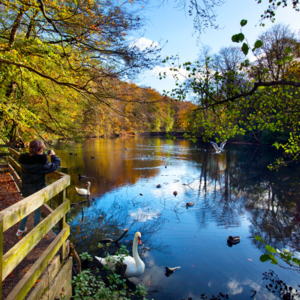Autumn seems a fleeting time lasting from the 1st September to the 30th of November, rich with the changing colours of nature, but also heralding the less attractive cold temperatures and short daylight hours. In the garden the pace of things is certainly slowing down and as many plants enter a resting period, our attention turns to generally tidying up, pruning and repairing.
I find that over the years the advice on how we should garden has changed, at one time autumn was considered a time to cut all herbaceous plants back, rake up all the fallen leaves and fork over borders between plants to give a neat and tidy finish. Current thinking is influenced by an increased awareness of nature, birds, wildlife, insects and all the other living organisms that take refuge in our gardens, so leaving dead plant stalks, seed heads, leaves on the borders and some discrete piles of twigs and vegetation creates a more welcoming and supportive environment for them.
It’s not an excuse to do nothing, more an understanding of the fact that we need to support nature, so we do often remove some of the dead plant material, particularly if the stems have collapsed or the seed heads are soggy and falling apart. We remove leaves from the lawn and from borders that we plan to do work on, but in more established shrubby areas where we do not plan to disturb the leaves are left where they fall, in fact as the leaves never fall exactly where you want them, we end up adding more to fill the gaps, in reality all you are doing is mulching.

A much more important task at this time of year and particularly as we move into winter is to try to spend some time outside, and our gardens provide a convenient place to take in the fresh air and light, even if that involves getting yourself wrapped up, grabbing a patio chair from the shed and a large hot drink, it is a known fact that staying indoors out of natural daylight for long periods is not good for you.
For those who are starting a new garden or developing an existing garden now is the time to start planting what we call bare root plants, (although you can continue to buy and plant pot grown plants), the advantage of bare root is that they are generally cheaper, healthier and have a much more developed root system. They are usually supplied wrapped in compostable packaging which avoids the need for a plastic pot.
The process for planting is exactly the same as for container grow plants although it is essential that you plant them as soon as you can, as they do not like to be out of the soil. If the weather is very wet or frozen then you can keep them in a frost free shed or garage for a few days, but if the site you have for them is not ready then it is best to keep them in outside. Choose a sheltered place in the garden, the empty vegetable plot is ideal, dig a shallow trench just deep enough to take all of the roots and a little of the stem, ideally the trench should have one straight side and one sloping which allows you to lay the plant at a 45 degree angle against the slope then backfill with the excavated soil, firm lightly and if the soil is dry water them in. They can stay like this until there is a break in the weather, but do try to plant them before the shoots start to grow in spring.
Mulching beds and borders is becoming increasingly important due, in some part to our changing climate. Mulching improves the texture of the soil, supports beneficial micro-organisms that live in the soil, and improves the capacity of the soil to hold moisture. As our climate moves towards more extreme weather patterns, ‘hot dry summers’ ‘long wet winters’ we need to help our soil and plants cope, and a key task is to add any type of garden compost, well rotted manure or organic mulch as a thick layer on all our planted borders in autumn/winter. Applying at this time will not only increase your soils capacity for holding moisture but will reduce any loss through evaporation next spring and summer, thereby avoiding the need to water your borders quite so much.
It is fair to say that we are a nation that is more in tune with recycling household waste than in the past, with some authorities providing several bins for different items, but I think we should take a closer look at our garden waste. At this time of year I see bins overflowing with leaves and whilst I understand the need to clear paths and lawns, taking them out of the garden is a waste.
When I see a wheelie bin full of leaves I see a bag of rich compost perfect for adding to containers and mulching borders, albeit after six months. I guess the frustration is stopping them blowing all over the garden so if space is limited the best approach is to use refuse sacks, the ones with tie handles are best as this makes them easy to inspect, whilst allowing a little air in which helps them rot down better. If you have quite a few bags then you can stack them up in the corner of the garden or along the fence/hedge line. Inspect them in January – February and if they are very dry give then a good dowsing with the watering can as this will speed up their break down, if you have any organic fertiliser then a small handful mixed into the leaves as you bag them up will also speed up the composting process. If all goes well you should be able to use them as mulch on your beds and borders in May next year (six months), if you plan adding to container compost it is best to leave them to break down completely which can take up to 12 months.
Happy Gardening,
Martin
Next month, (looking after christmas house plants, creating as dead hedge, planning for next year in the garden.)




